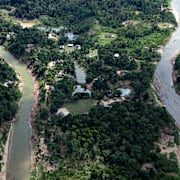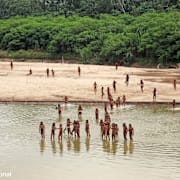
”Mirakelträd” skänker hopp till framtiden i Amazonas
Plantering av så kallade Inga-träd tros kunna bromsa eller stoppa avskogningen i Amazonas, skriver BBC. Förhoppningarna är höga när ett projekt med träden nu inletts.
– Det är ett mirakelträd eller superträd eftersom vissa av arterna kan göra fantastiska saker, säger Toby Pennington, professor i biogeografi och tropiska växter på Exeter universitet i Storbritannien.
Inga-trädet kan binda kväve till jorden vilket leder till att marken blir bördigare och produktiviteten ökar. Forskare hoppas att insatsen kommer övertyga småskaliga lantbrukare att inte sälja marken till stora företag.
bakgrund
Inga-träd
Wikipedia (en)
Inga (common name shimbillo) is a genus of small tropical, tough-leaved, nitrogen-fixing trees and shrubs, subfamily Mimosoideae. Inga's leaves are pinnate, and flowers are generally white. Many of the hundreds of species are used ornamentally.
Several related plants have been placed into this genus at one time, for example Yopo (Cohoba, Mopo, Nopo or Parica – Anadenanthera peregrina – as Inga niopo).The seeds are covered with sweet white powder. The pulp covering the seeds is lightly fibrous and sweet, and rich in minerals; it is edible in the raw state. The tree's name originates from the Tupi word in-gá meaning "soaked", due to the fruit powder consistency. The tree usually blossoms twice a year.
Within the Inga genus there are around 300 species, most of them native and growing in the Amazon forest region although some species are also found in Mexico, Greater and Lesser Antilles and other countries in South America, being an exclusively neotropical genus. The trees are usually found by river and lake edges because their seeds are carried there by floods.
All Inga species produce their seeds in "bean-like" pods and some can reach up to 1 m long, in general the pods are 10–30 cm long.
Trees can reach up to 15 metres and they are widely used for producing shade over coffee plants. The plant benefits from well drained soil. The flowers are white with some green and the tree can produce fruits almost all year long.
Inga species, most notably Inga edulis (commonly known as "ice-cream-bean" or, in Spanish, "guama", "guaba", "guaba de bejuco" or "paterna" depending on the country or region) often have edible pulp. The name derives from the fact that those of I. edulis resembles vanilla ice cream in flavour.
In Ecuador, Inga edulis is known as "guaba de bejuco" and, the other popular species there, Inga spectabilis
, as "guaba de machete".
Omni är politiskt obundna och oberoende. Vi strävar efter att ge fler perspektiv på nyheterna. Har du frågor eller synpunkter kring vår rapportering? Kontakta redaktionen



